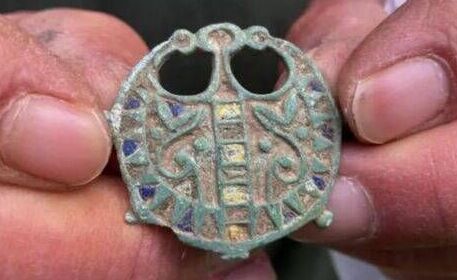Science
Metal Detectorist Unearths 2,000-Year-Old Brooch in Dorset

A metal detecting enthusiast, Martin Turner, has made an extraordinary discovery in the fields near his home in Puddletown, Dorset. Initially mistaking the find for a simple children’s toy, Turner unearthed a rare brooch dating back approximately 2,000 years. This remarkable artifact has now garnered attention for its historical significance, prompting plans for formal documentation.
After cleaning the brooch, Turner noticed signs of what is known as “bronze disease,” indicating that the piece possesses considerable antiquity. He promptly reported his find to a local finds liaison officer, who confirmed its potential historical value and is set to ensure the brooch is officially recorded. Should it remain unclaimed, Turner has indicated a willingness to donate it to a nearby museum.
Historical Context of the Discovery
Dating the brooch places it within the timeframe of the late Iron Age, specifically between the 1st century BC and the 1st century AD. This period coincides with the early stages of the Roman invasion of Britain, marking a significant era in the region’s history.
Turner, along with his son, began metal detecting as a hobby three years ago after moving to Dorset. Since then, they have uncovered numerous artifacts, using a secondhand metal detector purchased for around £600. In discussing his experiences, Turner shared with the BBC, “Every field I go in I find stuff. I must have 13 Chinese tubs full of antiquities.”
Among their most notable finds are 14 Bronze Age heads, which Turner described as “unreal.” He contributed these items to the British Museum, reflecting his commitment to preserving historical artifacts. In 2023, he expressed the thrill of holding pieces that had not been touched for over 4,500 years: “People spend all their lives trying to get one of these on their bucket list, and he’s been part of finding 14 of them. The feeling of holding them for the first time in 4,500 years – you’re the only person to hold these in that amount of time. That’s the excitement of it.”
Legal Framework and Treasure Designation
In England, Wales, and Northern Ireland, the Treasure Act 1996 defines an item as treasure if it is at least 300 years old. Items qualifying as treasure must also contain a minimum of 10% precious metal, such as gold or silver, by weight. Amendments to this law in 2023 expanded the definition to include artifacts over 200 years old that hold exceptional historical, archaeological, or cultural importance.
Once an item is designated as treasure and subsequently purchased by a museum, the discoverer is entitled to a monetary reward as compensation for their find. This system encourages the reporting of significant discoveries and ensures that historically important items are preserved for future generations.
As the story of Turner’s remarkable find unfolds, it underscores the excitement and historical value that can come from hobbies like metal detecting. With the possibility of the brooch being officially recorded and potentially displayed in a museum, it represents not only a personal achievement for Turner but also a contribution to the broader understanding of Britain’s rich history.
-

 Technology5 months ago
Technology5 months agoDiscover the Top 10 Calorie Counting Apps of 2025
-

 Health3 months ago
Health3 months agoBella Hadid Shares Health Update After Treatment for Lyme Disease
-

 Health3 months ago
Health3 months agoErin Bates Shares Recovery Update Following Sepsis Complications
-

 Technology4 months ago
Technology4 months agoDiscover How to Reverse Image Search Using ChatGPT Effortlessly
-

 Technology1 month ago
Technology1 month agoDiscover 2025’s Top GPUs for Exceptional 4K Gaming Performance
-

 Technology3 months ago
Technology3 months agoElectric Moto Influencer Surronster Arrested in Tijuana
-

 Technology5 months ago
Technology5 months agoMeta Initiates $60B AI Data Center Expansion, Starting in Ohio
-

 Technology5 months ago
Technology5 months agoRecovering a Suspended TikTok Account: A Step-by-Step Guide
-

 Health4 months ago
Health4 months agoTested: Rab Firewall Mountain Jacket Survives Harsh Conditions
-

 Lifestyle5 months ago
Lifestyle5 months agoBelton Family Reunites After Daughter Survives Hill Country Floods
-

 Health3 months ago
Health3 months agoAnalysts Project Stronger Growth for Apple’s iPhone 17 Lineup
-

 Technology4 months ago
Technology4 months agoHarmonic Launches AI Chatbot App to Transform Mathematical Reasoning











